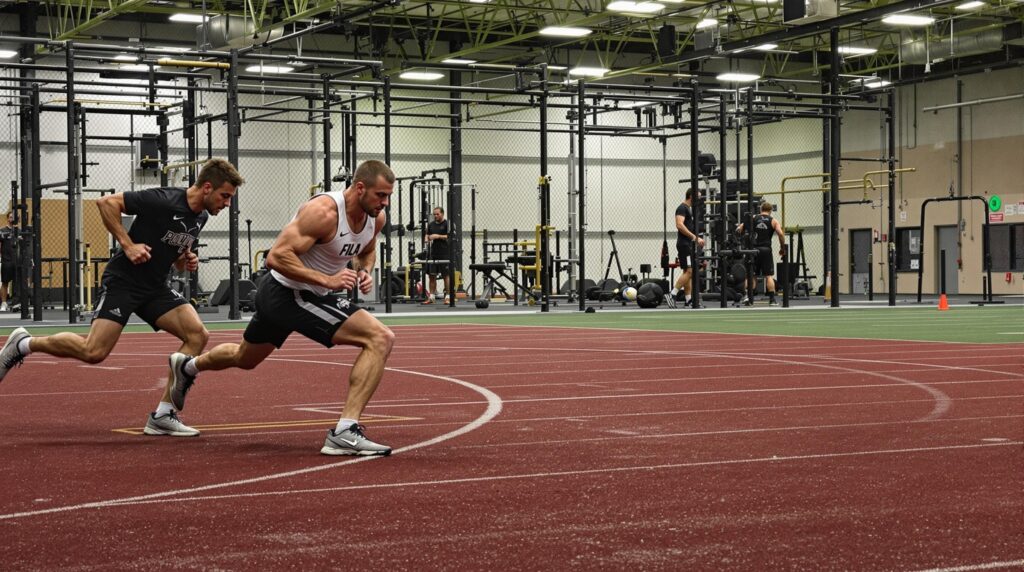Athletic ability goes far beyond just physical strength or speed—it encompasses a complex blend of physical capabilities, mental attributes, and disciplined habits that work together. Understanding what is considered athletic requires examining measurable benchmarks across various fitness components and recognizing that these traits are developed through consistent, strategic training rather than being purely innate talents.
Key Takeaways
- True athleticism comprises ten components including strength, speed, power, and mental resilience, not just one or two isolated abilities
- Elite athletes demonstrate specific benchmarks across multiple metrics—like VO₂ max values above 70 ml/kg/min and strength-to-weight ratios exceeding 1.5x bodyweight
- Strategic training through periodization cycles optimizes performance gains while preventing plateaus and injuries
- Proper nutrition with precise protein intake (1.8-2.7g/kg daily) and carbohydrate timing fuels athletic development
- Mental resilience and recovery habits like quality sleep are equally important as physical training methods in athletic development
Understanding Athleticism: A Comprehensive Definition
When exploring what is considered athletic, it’s essential to recognize that athleticism isn’t defined by a single trait but rather by a comprehensive set of attributes. True athleticism encompasses ten key components: strength, speed, power, agility, anaerobic and aerobic capacity, mobility, balance, coordination, mental resilience, and stability. These elements work together to create a foundation for physical excellence that transcends any single sport or activity.
One common misconception is that athletes are born, not made. While genetic factors certainly play a role, athletic traits are primarily developed through targeted training and disciplined habits. Elite performers don’t simply rely on natural talent—they systematically build their capabilities through structured programs, nutrition protocols, and recovery strategies that enhance each component of athleticism.
The distinction between athletes and non-athletes can be measured across multiple physiological parameters. From VO₂ max values to strength-to-weight ratios, these objective benchmarks provide clear evidence of athletic development and potential. However, numbers alone don’t tell the complete story—the mental aspect of athletics, including focus, resilience, and strategic thinking, completes the athletic profile.

Strength and Power: The Foundation of Athletic Performance
Strength serves as the fundamental building block of athletic performance, providing the raw force production necessary for virtually all sports movements. Male collegiate athletes typically demonstrate squat capabilities of approximately 1.5 times their body weight, while female athletes average about 1.2 times body weight. These benchmarks reflect the significant strength foundation required for high-level performance.
When examining upper body strength, the differences remain notable. Intermediate male lifters typically bench press around 217 pounds, with advanced lifters reaching the 291-pound benchmark. Female intermediate lifters average around 111 pounds on the bench press. These figures highlight not only gender differences but also the progressive nature of strength development through dedicated training.
Power—the combination of strength and speed—manifests in explosive movements like the vertical jump. For men aged 20-29, an “excellent” vertical jump rating starts at 58 centimeters or higher, while women in the same age group achieve an excellent rating at 30 centimeters or above. Power production is particularly crucial for athletes using Olympic lifts like power cleans to enhance their explosive capabilities.
Both absolute strength (total force production) and relative strength (strength-to-weight ratio) matter in athletics, with their importance varying by sport. A powerlifter focuses more on absolute strength for maximum lift numbers, while a gymnast prioritizes relative strength to control body weight efficiently during complex movements.
Speed, Agility and Coordination: Movement Efficiency Metrics
Speed represents one of the most visible athletic attributes, with elite male athletes completing the 40-yard dash in just 4.6-4.9 seconds, while recreational female athletes average around 5.8 seconds. These sprint capabilities translate directly to performance advantages in sports from football to soccer, where rapid acceleration can create scoring opportunities.
Agility—the ability to change direction quickly while maintaining control—is assessed through tests like the T-test, where male athletes typically complete the course in approximately 10 seconds and females in 10-12 seconds. This lateral quickness and body control are essential qualities for court and field sports that require rapid direction changes in response to opponents or game situations.
Flexibility also plays a crucial role in athletic movement. The sit-and-reach test provides normative data, with males (ages 20-29) achieving 29 centimeters or more and females reaching 30 centimeters or more for above-average scores. This mobility directly impacts an athlete’s movement range and injury prevention potential.
Coordination training through ladder footwork drills and specialized movement patterns enhances neural pathways that control precise movements. These exercises improve motor learning and neuromuscular efficiency, resulting in more fluid, economic movement patterns and reduced injury risk during complex athletic maneuvers.
Endurance and Aerobic Capacity: The Engine of Athletic Performance
VO₂ Max—the maximum rate of oxygen consumption during exercise—serves as the gold standard measurement for aerobic capacity. Male endurance athletes typically score between 70-85 ml/kg/min, dramatically higher than the average sedentary value of approximately 42 ml/kg/min. This stark difference illustrates the profound physiological adaptations that separate elite endurance athletes from the general population.
The upper limits of human aerobic capacity are exemplified by Norwegian cross-country skiing legend Bjorn Daehlie, who reportedly achieved a VO₂ Max of 93-95 ml/kg/min—among the highest ever recorded. Female elite athletes typically reach VO₂ Max values between 72-80 ml/kg/min, with these extraordinary capabilities reflecting both genetic predisposition and years of targeted cardiovascular training.
High-Intensity Interval Training (HIIT) has revolutionized endurance development by increasing aerobic capacity 10-15% faster than traditional steady-state cardio. A particularly effective protocol involves 4×4-minute intervals at 90-95% of maximum heart rate, separated by recovery periods. This approach maximizes cardiovascular adaptations while minimizing total training time.
Endurance training produces numerous physiological adaptations, including increased heart stroke volume, enhanced capillary density, greater mitochondrial efficiency, and improved blood volume. These changes allow athletes to deliver and utilize oxygen more effectively during prolonged exercise, pushing back the threshold at which fatigue occurs.
Periodization: Strategic Training Structure for Athletic Development
Periodization divides training into organized cycles to optimize performance gains while preventing burnout. At the highest level, macrocycles represent annual or quadrennial plans that might culminate in a championship season or Olympic Games. These long-term roadmaps ensure that athletes peak at the right moments rather than burning out prematurely.
Within each macrocycle, mesocycles typically span 4-6 weeks and target specific fitness components like strength, power, or endurance. A common approach involves progressive overload for three weeks followed by a strategic deload week to allow for recovery and adaptation. This wave-like progression prevents plateaus while reducing injury risk.
The smallest unit of periodization, the microcycle, usually represents a weekly training schedule that balances work and recovery. A typical microcycle might include:
- High-intensity strength training (Monday/Thursday)
- Speed and agility work (Tuesday)
- Energy system development (Wednesday/Saturday)
- Active recovery or mobility work (Friday)
- Complete rest (Sunday)
This systematic approach to training organization has been adopted by virtually all world-class athletes and their coaches. The intentional variation in training stimuli creates a progressive overload that drives adaptation while preventing the stagnation that often results from repeating identical workouts indefinitely.
Sport-Specific Training Methods: Tailored Athletic Development
Different sports demand unique combinations of athletic traits, requiring specialized training methods. Plyometric exercises like box jumps and depth jumps develop the explosive power essential for jumping sports such as volleyball and basketball. These movements train the stretch-shortening cycle of muscles, enhancing the body’s ability to generate maximum force quickly.
Court and field sports athletes benefit tremendously from agility ladder and cone drill training that enhances lateral movement capabilities. These drills improve footwork precision, change-of-direction mechanics, and reaction time—all critical components for sports that require rapid responses to unpredictable situations.
Resistance training provides a dual benefit by increasing both structural strength and hormonal response. Properly designed strength programs stimulate testosterone and growth hormone production, creating a favorable anabolic environment for muscle hypertrophy and recovery. The specific resistance methods should match the sport’s demands—power athletes focus on explosive lifts while endurance athletes emphasize muscular endurance.
Sport-specific training must ultimately address the precise movement patterns and energy systems used in competition. A sprinter needs different training than a marathon runner, just as a CrossFit athlete requires different preparation than a gymnast. The most effective programs match training stimuli to competitive requirements through careful analysis of the sport’s demands.
Nutrition and Recovery: Fueling Athletic Performance
Proper nutrition provides the building blocks for athletic development, with protein requirements ranging from 1.8-2.7 grams per kilogram of body weight daily to support muscle growth and maintenance. This substantial protein intake exceeds general population recommendations because athletes continuously break down and rebuild muscle tissue through training.
Carbohydrates serve as the primary fuel source for high-intensity exercise, with endurance athletes requiring 6-10 grams per kilogram daily to maintain glycogen stores. Strategic carbohydrate timing—consuming most carbs around training sessions—helps maximize performance while supporting body composition goals during different training phases.
Healthy fats should comprise 20-35% of total caloric intake to support hormone production, including testosterone and growth hormone that drive recovery and adaptation. These essential fatty acids also provide anti-inflammatory benefits that help manage the physical stress of intense training.
Hydration strategies begin with pre-loading approximately 500 milliliters of water two hours before exercise. During activity, athletes should aim to replace fluid at a rate that prevents both dehydration and overhydration—typically 500-1000 milliliters per hour depending on sweat rate, temperature, and exercise intensity.
Quality recovery requires 7-9 hours of nightly sleep, when the body releases its highest concentrations of growth hormone. Strategic naps lasting 30 minutes or less can provide additional recovery benefits without disrupting nighttime sleep patterns. Physical recovery techniques like foam rolling and contrast baths can reduce muscle soreness by 20-30%, allowing for more consistent training quality.



